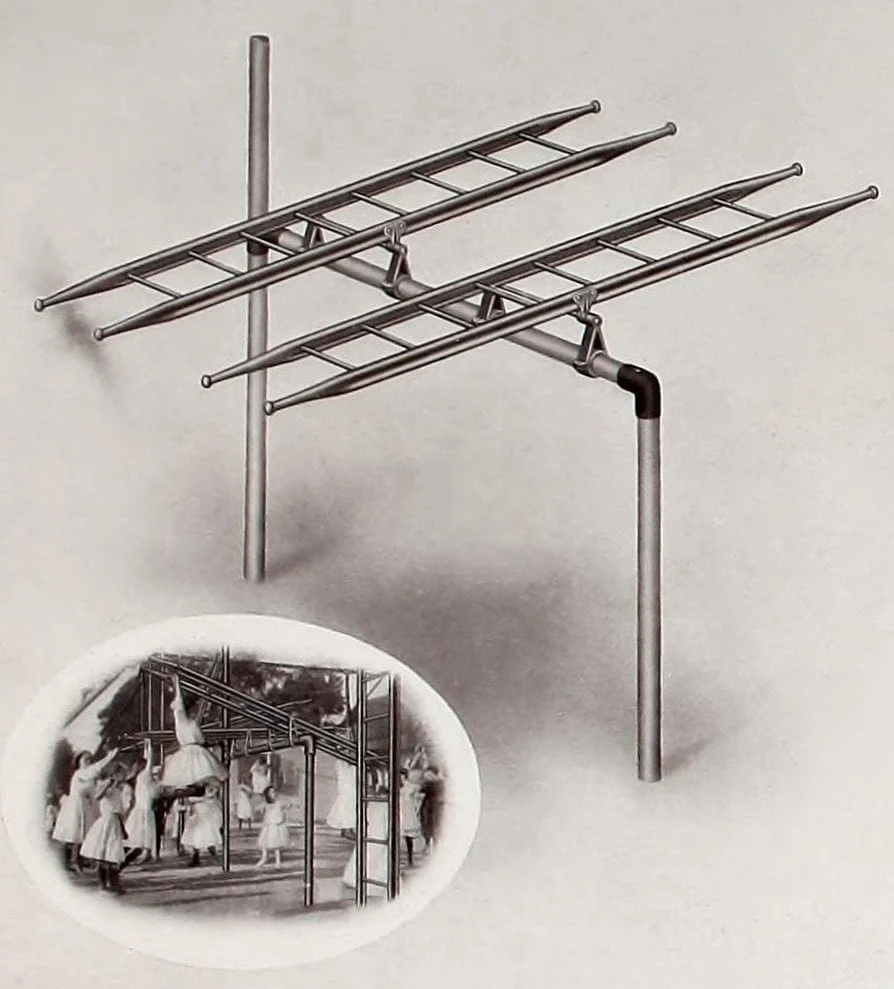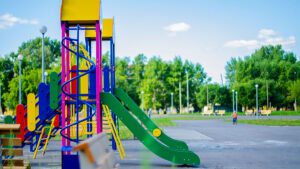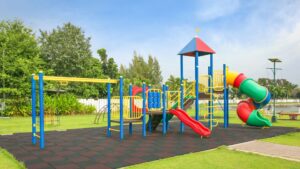За прошедшие годы оборудование для детских площадок претерпело значительные изменения, и его приоритетом стала безопасность детей, при этом времяпрепровождение остается веселым и познавательным. Если вы посмотрите на оборудование для детских площадок, запрещенное в течение многих лет, вы быстро поймете, как далеко мы продвинулись в плане дизайна, безопасности и материалов. Устаревшие конструкции и опасные материалы приводили к многочисленным травмам, и эти усовершенствования отражают наше стремление создать более безопасные места для детей. В этой статье мы подробно рассмотрим десять самых странных предметов для детских площадок, которые были запрещены, и выясним, почему они были признаны опасными.
Почему оборудование для детских площадок запрещено
На протяжении истории оборудование детских площадок претерпевало значительные изменения, одним из наиболее значимых стимулов которых стало повышенное внимание к безопасности детей. Старые игровые площадки оснащались оборудованием, которое часто было небезопасным, с опасными материалами, такими как бетонный пол и металлические конструкции, что приводило к большому количеству травм.
В прошломСтандарты безопасности часто были минимальными, и многие конструкции детских площадок не проходили реальных испытаний на безопасность перед установкой в школах и парках. Например, качели с высокими качелями и твердыми материалами были обычным явлением, но эти опасные конструкции иногда становились причиной серьезных несчастных случаев.
Сегодня правила безопасности стали намного строже, оборудование требует одобрения со стороны таких руководящих органов, как Комиссия по безопасности потребительских товаров (CPSC) перед тем, как попасть в детские игровые зоны. Эти стандарты привели к значительным улучшениям, сделав игровые площадки более безопасными и доступными для детей с любыми способностями.
История и эволюция оборудования для детских площадок
Первые игровые площадки отличались простыми конструкциями, такими как брусья для обезьян, карусели, и качающиеся бревна. Однако многие из этих устройств были построены без учета требований безопасности: они часто имели острые края или были изготовлены из твердых и опасных материалов, таких как бетон.
С введением новых тестов на безопасность конструкция оборудования для детских площадок радикально изменилась. Например, оборудование, изготовленное из свинцовая краска и опасные металлы были заменены на более прочные и безопасные для детей материалы, такие как резиновая мульча и древесная стружкаОни помогают поглощать удары и снижают риск получения травм.
Из-за чего запрещают оборудование для детских площадок?
Оборудование для детских площадок запрещают по разным причинам, но главная из них - безопасность. В прошлые десятилетия оборудование для детских площадок не проходило никаких серьезных испытаний, прежде чем его устанавливали в общественных местах. Как мы узнали из многочисленных несчастных случаев, в старых конструкциях часто отсутствовали такие важные элементы, как амортизирующие поверхности и соответствующие материалы, которые могли бы свести к минимуму риск травм.
Например, деревянные игровые площадки Когда-то они были доминирующими во многих парках, но в основном вышли из употребления, поскольку вызывали занозы и требовали тщательного ухода. Аналогично, бетон поверхности, гравий, и тяжелый металл Компоненты представляли собой такие риски, как Сотрясения мозга, ссадиныи даже отравление в случае с красками на основе свинца. Потребность в более безопасных и ухоженных игровых площадках привела к значительным изменениям в дизайне этих помещений.
Десять лучших запрещенных приспособлений для детских площадок
Ниже мы рассмотрим десять самых опасных и странных предметов оборудования для детских площадок прошлого. Эти предметы были запрещены не только из-за их странного дизайна, но и из-за того, что они представляли значительный риск для безопасности.
1. Распашные ворота
Качающиеся ворота были популярным, но крайне опасным элементом детской площадки. Ворота крепились к одному столбу, и дети держались за перекладину, пытаясь раскачаться вокруг столба. Не имея надежной платформы, дети рисковали упасть и даже зацепиться пальцами ног за перекладину. Тяжелые, часто металлические, ворота представляли собой риск получения травмы, что делало их одной из главных опасностей на детских площадках.
2. Гигантские шаги
Гигантские прогулки", вдохновленные традицией майского столба, представляли собой большой вертикальный шест с привязанными к нему веревками. Дети бегали вокруг шеста и пытались подпрыгнуть в воздух, чтобы на мгновение взлететь. Однако эта конструкция требовала большой координации и командной работы, и многие дети сталкивались друг с другом или с шестом, что приводило к ссадинам и серьезным травмам.

3. Качели из бревна
Бревенчатые качели - это длинная деревянная или металлическая балка, на которой дети раскачивались взад-вперед. Проблема? Она могла непредсказуемо раскачиваться из стороны в сторону, особенно когда на ней толпилось несколько детей. Отсутствие контроля и тяжесть качелей приводили к серьезным несчастным случаям, часто дети врезались друг в друга или в саму конструкцию.
4. Лестница Teeter Ladder
Сочетая в себе тренажерный зал в джунглях и киберспортсмена, Teeter Ladder представлял собой конструкцию, состоящую из двух лестниц, прикрепленных к горизонтальной перекладине. Когда дети взбирались по лестнице, перекладина наклонялась, вызывая резкое и потенциально опасное движение. Такое оборудование часто становилось причиной падений и травм, особенно если дети теряли хватку или координацию.

5. Безопасные качели
Предназначенные для безопасного спуска детей в бассейн, качели Poised Safety Swing оказались гораздо опаснее, чем можно было предположить из их названия. Конструкция качелей включала в себя высокую лестницу, по которой дети взбирались, а затем сбрасывались в водоем. Однако механизм иногда выходил из строя, что приводило к падению детей с большой высоты. Из-за того, что качели могли нанести вред как самому катающемуся, так и окружающим, их запретили.

6. Слайды Racer
Горки Racer - это высокие металлические горки, призванные удовлетворить детскую тягу к скорости. Однако эти горки были не только узкими, но и чрезвычайно опасными. Дети часто поскальзывались, а летом горки становились опасно горячими, что приводило к ожогам. Большая высота этих горок также создавала значительный риск получения травм при приземлении.
7. Шляпа ведьмы
Ведьмина шляпа" представляла собой карусель с центральным шестом и вращающейся рамой. Дети могли бегать вокруг рамы или цепляться за нее, когда она вращалась. Однако риск провалиться сквозь конструкцию, попасть в ловушку или удариться о столб на большой скорости делал ее небезопасным оборудованием. Сегодня существуют его более безопасные версии, которые предотвращают падение и имеют меньшую скорость вращения.
8. Качели для животных
Эти качели были выполнены в форме животных, таких как утки или куры, и обычно были очень красочными. Несмотря на забавный внешний вид, они были очень тяжелыми и сложными в управлении. Дети часто получали травмы из-за того, что качели ударялись о них или врезались в других детей. Кроме того, тяжелая металлическая конструкция делала эти качели опасными, особенно когда на них падали дети.
9. Бочка веселья
Бочка веселья" представляла собой большую бочку, которая вращалась вокруг центрального шеста. Дети пытались удержаться на бочке, когда она вращалась, или пытались выполнить трюки, например кувырки. Бочка часто достигала опасно высоких скоростей, сбрасывая детей и нанося им травмы. Твердая бетонная поверхность, на которой она стояла, также делала ее небезопасной.
10. Гигантская горка (Racer Slide)
Эти массивные металлические горки были характерны для многих детских площадок в середине XX века. Несмотря на то что многие дети испытывали восторг от скольжения на большой скорости, эти горки были узкими, сделанными из раскаленного металла и представляли значительную опасность. Опасность падения с горки или неправильного приземления на твердую поверхность привела к тому, что эти конструкции в конечном итоге были сняты с производства.
Влияние запрещенного оборудования на современные игровые площадки
Запрет этих конструкций сформировал те игровые площадки, которые мы видим сегодня. Современные игровые площадки теперь оснащены более безопасным и доступным оборудованием, предназначенным для предотвращения травм. Такое оборудование, как стена для скалолазания, резиновые качели, и перевернутые тележки обеспечивают такие же острые ощущения без риска. В дизайне игровых площадок также уделяется особое внимание инклюзивности, предлагая такие функции, как Качели с доступом для инвалидных колясок и пересадочные станции чтобы все дети, независимо от их способностей, могли наслаждаться игровой площадкой.
Роль технологий в обеспечении безопасности игровых площадок
Технологии играют важную роль в безопасности современных игровых площадок. Благодаря инновациям в материалах и средствах безопасности, таких как ударопоглощающие поверхности и Более безопасные материалы для качелейОборудование для детских площадок стало более прочным и безопасным, чем когда-либо прежде. Достижения в области дизайна привели к появлению более совершенных систем контроля, которые помогают выявлять и устранять потенциальные проблемы безопасности до того, как произойдет несчастный случай.
Кроме того, технологические инструменты, такие как сенсорные системы мониторинга и детские ворота безопасности помогли обеспечить безопасность игровых площадок для всех детей. Благодаря этим технологическим достижениям детские площадки сегодня не только веселее, но и значительно безопаснее.
Заключение
За прошедшие годы стандарты безопасности детских площадок прошли долгий путь. Хотя дизайн многих старых игровых площадок может показаться забавным и инновационным, они часто были небезопасны и приводили к частым травмам. Сегодня безопасность и доступность - главные приоритеты при проектировании детских площадок. По мере того как мы продолжаем разрабатывать более совершенные материалы и технологии, детские площадки будут становиться только безопаснее, обеспечивая детям веселую и безопасную среду для игр и развития.




